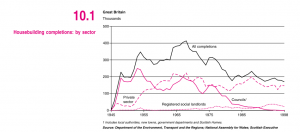An article in Bloomberg claims: “Yup, rent control does more harm than good: Economists put the profession’s conventional wisdom to the test, only to discover that it’s correct.” The reference to the conventional wisdom – “Economics 101” – refers to two basic precepts of economic theory. If prices are restricted, it reduces supply and increases demand. If prices are not set at a market level, it reduces the efficiency of the allocation, leaving people worse off than they might otherwise be. On the face of the matter, that is what the paper seems to confirm. I’m not currently able to access the paper, but what the abstract says is this:
“we find rent control increased renters’ probabilities of staying at their addresses by nearly 20%. Landlords treated by rent control reduced rental housing supply by 15%, causing a 5.1% city-wide rent increase.”
I’ve no reason to dispute that finding. What I do dispute is the idea that this constitutes a general proof of the application of basic economic theory in this field. San Francisco is one city, with one type of policy. In most of Europe, the private rented sector is larger where there are rent controls: see R. Arnott, 1995, “Time for revisionism on rent control?”, Journal of Economic Perspectives 9(1) 99-120. In the UK, the removal of controls in 1957 led to a radical reduction in supply, as landlords took the opportunity to shift to alternative investments. The removal of controls in 1988 had very little immediate effect: leaving aside stock transfers from the public sector, much of the increase in private renting has taken place since 2007, reflecting low rates of return on alternative investments. Putting it bluntly, we already know – or should know – that Economics 101 doesn’t reflect what is actually happening out there in the real world.
The central objection to applying basic economic theory in this context is simple enough: it’s much too basic. It works on the idea that “other things are equal”, and they never are. Rental markets are invariably complex. Rent controls are not the only determinant of rents; they’re one factor of many, including the ability to pay and the existence of alternatives (such as low cost owner-occupation). No less important, a landlord’s decision to rent is never, repeat never, determined by rental levels alone. It has to balance that factor along with capital values (“rates of return” are a relationship between the two), alternative uses of capital, the implications of holding an illiquid asset, and the prospect of capital gain or loss. So the report that some landlords are converting rented flats into new condominiums is not a reflection on rents; it’s a reflection of a complex calculation, which may work out differently in different places at different times.
